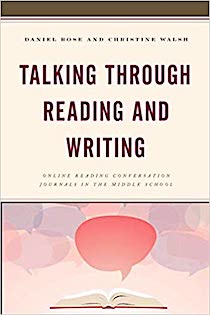5 Reasons to Journal Online with Students
Making room and time for teacher-student talk in our literacy classes.

We live in an ever-accelerating world.
A world which values the short and sweet over the long and winded.
In a world full of furiously fast talk in the form of 280 character tweets, Snapchat captions, emoji-riddled text messages and pint-sized Facebook posts, we are left to wonder what happened to the days of longer conversation: the back and forth passing of hand-written notes, hour long chats on wall-mounted phones, face to face dialogue over a sit-down dinner.

Our students, our writers, our thinkers, are growing up using this truncated, staccato communication littered with sentence fragments, lower case letters, abbreviations and no punctuation, and their attention spans and stamina for reading and writing have suffered.
Are the days of meaningful, sustained conversation gone?
More than ever, students need frequent chances to express and develop thoughts and feelings through the written word, to reflect and ask questions, to construct ideas about the world around them, to complain and argue in writing, to understand and name emotions, to wonder, to learn, to grow.
But how?
The Competing Demands of Today’s Teacher
To say that a teacher’s job these days is multifaceted is a serious understatement, and does a disservice to the artful ways in which teachers employ their creativity and industriousness to reach students. The advent of the Coronavirus and the subsequent dominance of remote learning only intensifies the challenges associated with providing a rich learning environment for all students.
In addition to supplying an engaging, challenging (yet accessible) curriculum, teachers are expected to promote opportunities every day for social emotional learning and social justice inquiry. Teachers are tasked with making deep connections with each and every student to help foster a learning community in the classroom – a positive, fun, engaging atmosphere which leads to happier students more willing to show up, to participate, to behave.
The incredible demands of the modern-day teacher are undeniable.
It is no wonder we move so fast in the classroom, tirelessly working to keep our heads above water, our feet and arms flailing underneath the surface. In an educational merry-go-round which everyday seems to be spinning with more and more mandates, it seems only logical to speed up.
Maybe slowing down is the answer.
How Conversation Can Help
The benefits of student/teacher conferences are no secret in the education world. Literacy gurus – from Atwell to Calkins to Beers & Probst and more recently Gallagher & Kittle – stress the importance of conferring with students on a regular basis.
Through regular meetings and conversations with students, teachers can address individual learning needs at a pace that works for the student; attend to social emotional learning needs and social justice complexities; build student confidence with regard to reading and writing; set and assess personalized learning goals; collect data to help drive classroom and differentiated instruction; foster deep, meaningful connections; challenge students to push themselves beyond the required expectations; and build a community of learners more willing to engage with the course content.
The online Reading Conversation Journal (RCJ)
How do we find the time? During and after the pandemic, teachers at any grade level in any subject area can utilize an online conferencing platform like Google Docs to converse virtually with every student. Online journals offer our students a place to document feelings, thoughts, and reactions to a variety of texts, while simultaneously providing opportunities to make personal, social and academic connections with their teacher.
Here’s a sample from Dan’s class of a typical student-teacher RCJ exchange:
Sophia:
I read the most before I go to sleep. I find myself at my peak of distraction before I go to sleep, so one thing I do to focus myself is read. One thing I hate about reading is when a book ends very badly and the entire book was all just a waste. I learned everything about the characters and I created the setting in my head all for the main character to die. Those types of books are the type I buy thinking I’ll reread them over and over but then only read once and end up on the bottom shelf on the bookshelf.
Mr. Rose:
I know what you mean about bad endings. It’s like you spent so many hours reading and reading hoping for some sort of reward at the end . . . and then . . . NOTHING! I know a lot of things about this year have been challenging, but I wanted to ask you about the reading you are doing on your own: Are you finding any time to read at home? Are you reading regularly? How many books have you started and finished this school year? What types of books do you still want to read this year? What is the most challenging thing about reading at home? Thanks for taking the time to answer some (or all) of my questions, Sophia. Looking forward to reading what you have to say.
Sophia:
I have found/made much more time to read in the past year, especially during the weekends. This year I believe I have read close to 8 books so far. I still like to read fantasy novels or books about adventure, but I’m also starting to get into more classic books. I think the most challenging thing about reading at home is my schedule. See in school I could read without distraction, but now that I’m home it seems like every opportunity to read is pushed away because of dance being later or doing homework for a longer time.
Mr. Rose:
Very true, Sophia. I find the same thing is happening with me. Tougher to make the time to read with so many ‘other’ things to do at home. Can you tell me about the book you are currently reading?
Sophia:
Right now I am reading Harry Potter and the Sorcerer’s Stone, and I think everyone knows what it’s about. When I say focus myself, I am talking about instead of letting my mind wander to my phone or my TV, I let my mind wander into the book. I can fall asleep working my brain, not staring at a screen.
Five benefits of digital conferencing
► A More Deliberate Teaching Approach
It’s asynchronous. When neither student nor teacher is rushed, the ability to respond with careful thought and consideration increases dramatically. Response can arrive with more accuracy, thought and depth. This micro-tailored instruction is near impossible in traditional face-to-face reading-writing conferences where reactions happen rapidly and in the midst of the moment. Teachers can also choose when and where to respond.
► Access to the Internet
With access to the World Wide Web, the information universe is at our teaching fingertips. Suddenly, book trailers and reviews are a click away for readers in search of their next great title. Newspaper articles about video games are shareable and linkable. Virtual book stacks, movie trailers, music videos, podcasts, blog posts, audio clips – any and all forms of media and teaching material become available to help meet students’ diverse needs.
► Natural Differentiation
Because student online responses are readily available, teachers can differentiate more efficiently. Conferring regularly with learners allows teachers to listen closely to the needs of every student in the classroom and then instruct each student as part of the conversation, based on their needs at that time. Conferring online allows teachers the flexibility and time to elaborate on initial ideas and ensure more thoughtful, finely-tuned responses, guiding each student to the next step in their literacy development.
► Easy Record Keeping
One of the most difficult aspects of traditional side-by-side conferencing is keeping track of it all:
What did she say last time we met? With whom should my next conference be? How many times have I met with this student this month?
All of these questions become moot with online conferences. A quick scroll through the response thread will tell us everything we need to know about the student’s progress. Students can also visually trace their growth from beginning of year to end. Teachers will appreciate these conversations come parent conference time. Teachers are able to copy and paste excerpts and even full entries from journals to illustrate a student’s reading-writing progress through a school year. It’s an ongoing formative assessment tool.
► SEL and the Power of Connection
More than two decades of research shows that social-emotional learning leads to increased academic achievement, improved behavior, and a strong return on investment. Addressing academic, social, and emotional needs is crucial for engagement and learning, motivation and trust. Within the private spaces of these online journals, we have that opportunity.
Knowing that we will get another chance to check in with each and every one of our students also provides us peace of mind. Priceless.

Dr. Christine Walsh is a visiting assistant professor at the State University of New York, Oswego, PDS (Professional Development School) liaison, and literacy coach/consultant. She lives in Baldwinsville, NY, with her husband Brian, son James, and golden retriever Bailey.
Dan and Christine are the authors of Talking through Reading and Writing: Online Reading Conversation Journals in the Middle School (Rowman & Littlefield, 2020). You can email them directly at drose@oswego.org and christine.walsh@oswego.edu.



































